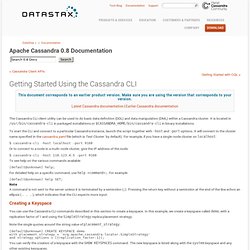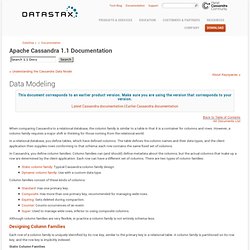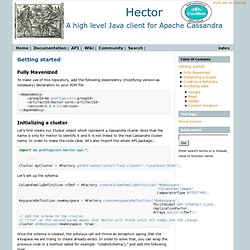

Cassandra Data Model. Cassandra concepts, patterns and anti-patterns. Getting Started Using the Cassandra CLI. The Cassandra CLI client utility can be used to do basic data definition (DDL) and data manipulation (DML) within a Cassandra cluster.

It is located in /usr/bin/cassandra-cli in packaged installations or $CASSANDRA_HOME/bin/cassandra-cli in binary installations. To start the CLI and connect to a particular Cassandra instance, launch the script together with -host and -port options. It will connect to the cluster name specified in the cassandra.yaml file (which is Test Cluster` by default). For example, if you have a single-node cluster on localhost: $ cassandra-cli -host localhost -port 9160 Or to connect to a node in a multi-node cluster, give the IP address of the node: $ cassandra-cli -host 110.123.4.5 -port 9160 To see help on the various commands available: For detailed help on a specific command, use help <command>;.
[default@unknown] help SET; Note A command is not sent to the server unless it is terminated by a semicolon (;). DataStax Cassandra 1.1 Documentation. When comparing Cassandra to a relational database, the column family is similar to a table in that it is a container for columns and rows.

However, a column family requires a major shift in thinking for those coming from the relational world. In a relational database, you define tables, which have defined columns. The table defines the column names and their data types, and the client application then supplies rows conforming to that schema: each row contains the same fixed set of columns. In Cassandra, you define column families. Column families can (and should) define metadata about the columns, but the actual columns that make up a row are determined by the client application. Static column family: Typical Cassandra column family design.Dynamic column family: Use with a custom data type. Column families consist of these kinds of columns: Although column families are very flexible, in practice a column family is not entirely schema-less. Designing Column Families Static Column Families. Overview Twitter4j. REST API v1.1 Resources. Getting started — Hector - Java Client for Cassandra.
Let’s first create our Cluster object which represent a Cassandra cluster.

Note that the name is only for Hector to identify it and it is not linked to the real Cassandra cluster name. In order to make the code clear, let’s also import the whole API package.: import me.prettyprint.hector.api.*; ..... Let’s set up the schema: ColumnFamilyDefinition cfDef = HFactory.createColumnFamilyDefinition("MyKeyspace", "ColumnFamilyName", ComparatorType.BYTESTYPE); KeyspaceDefinition newKeyspace = HFactory.createKeyspaceDefinition("MyKeyspace", ThriftKsDef.DEF_STRATEGY_CLASS, replicationFactor, Arrays.asList(cfDef));// Add the schema to the cluster.// "true" as the second param means that Hector will block until all nodes see the change.cluster.addKeyspace(newKeyspace, true); Once the schema is created, the previous call will throw an exception saying that the Keyspace we are trying to create already exists. Keyspace ksp = HFactory.createKeyspace("MyKeyspace", myCluster);
Specification - GSoC Graph Streaming API - Gephi:Wiki. Student: Andre Panisson Mentor: Mathieu Bastian Goal of the Project The goal of this project is to set up a framework for graph streaming in Gephi.

A high-quality API proposal should be sufficiently general to provide interoperability with other available tools. The more general is the API proposal, a larger number of tools should be able to implement it and to interoperate. Specifications A unified framework for graph streaming should include functionalities to add, remove and modify graph entities (nodes and edges), and also operations to retrieve and monitor graph information.
The Graph Streaming API can be divided in 2 different types of operations, grouped by functionality. A totally new API called StreamingAPI will be created, based in the current ImportAPI, which already separates importing from processing data to the main data structure by using a container. Operations The first group consists of read operations, and do not imply in any change in the graph: Veille Techno.